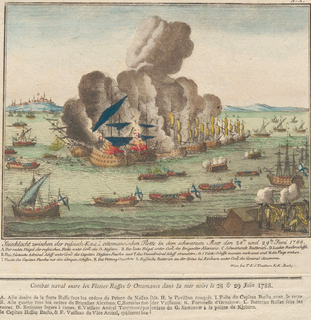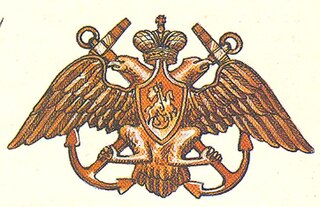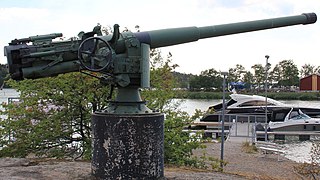Related Research Articles

The Russian Naval Infantry, often referred to as Russian Marines in the West, operate as the naval infantry of the Russian Navy. Established in 1705, they are capable of conducting amphibious operations as well as operating as more traditional light infantry.

The term brown-water navy or riverine navy refers in its broadest sense to any naval force capable of military operations in littoral zone waters. The term originated in the United States Navy during the American Civil War, when it referred to Union forces patrolling the muddy Mississippi River, and has since been used to describe the small gunboats and patrol boats commonly used in rivers, along with the larger "mother ships" that supported them. These mother ships include converted World War II-era Landing Crafts and Tank Landing Ships, among other vessels.

A flotilla, or naval flotilla, is a formation of small warships that may be part of a larger fleet.

The Romanian Navy is the navy branch of the Romanian Armed Forces; it operates in the Black Sea and on the Danube. It traces its history back to 1860.

The Gunboat War was a naval conflict between Denmark–Norway and the British during the Napoleonic Wars. The war's name is derived from the Danish tactic of employing small gunboats against the materially superior Royal Navy. In Scandinavia it is seen as the later stage of the English Wars, whose commencement is accounted as the First Battle of Copenhagen in 1801.

This was a series of mainly small-ship actions which occurred along the coast of what is now Ukraine during the Russo-Turkish War (1787–1792) as Russian and Turkish ships and boats supported their land armies in the struggle for control of Ochakov, a strategic position. The main actions at sea happened on 17, 18, 28 and 29 June and 9 July 1788. On 9 July also, the larger Turkish ships left and on 14 July they fought the Russian Sevastopol fleet about 100 miles to the south.

The Imperial Russian Navy operated as the navy of the Russian Tsardom and later the Russian Empire from 1696 to 1917. Formally established in 1696, it lasted until dissolved in the wake of the February Revolution of 1917. It developed from a smaller force that had existed prior to Tsar Peter the Great's founding of the modern Russian navy during the Second Azov campaign in 1696. It expanded in the second half of the 18th century and reached its peak strength by the early part of the 19th century, behind only the British and French fleets in terms of size.

The Caspian Flotilla is the flotilla of the Russian Navy in the Caspian Sea.

The Azerbaijan Navy is the naval component of the Azerbaijani Armed Forces operating in the Caspian Sea.

The Chesapeake Bay Flotilla was a motley collection of barges and gunboats that the United States assembled under the command of Joshua Barney, an 1812 privateer captain, to stall British attacks in the Chesapeake Bay which came to be known as the "Chesapeake Campaign" during the War of 1812. The Flotilla engaged the Royal Navy in several inconclusive battles before Barney was forced to scuttle the vessels themselves on August 22, 1814. The men of the Flotilla then served onshore in the defense of Washington, DC and Baltimore. It was disbanded on February 15, 1815, after the end of the war.

USS Mound City was a City-class ironclad gunboat built for service on the Mississippi River and its tributaries in the American Civil War. Originally commissioned as part of the Union Army's Western Gunboat Flotilla, she remained in that service until October 1862. Then the flotilla was transferred to the Navy and she became part of the Mississippi River Squadron, where she remained until the end of the war.

A landlocked navy is a naval force operated by a country that does not have a coastline. While these states are unable to develop a sea-going, blue-water navy, they may still deploy armed forces on major lakes or rivers.

The Pook Turtles, or City-class gunboats to use their semi-official name, were war vessels intended for service on the Mississippi River during the American Civil War. They were also sometimes referred to as "Eads gunboats." The labels are applied to seven vessels of uniform design built from the keel up in Carondelet, Missouri shipyards owned by James Buchanan Eads. Eads was a wealthy St. Louis industrialist who risked his fortune in support of the Union.

The British Caspian Flotilla was a naval force of the Royal Navy established in the Caspian Sea in 1918. It was part of the allied intervention in the Russian Civil War. The flotilla initially reported to the Rear-Admiral Commanding, Black Sea, Caspian Sea and Sea of Marmora until 1919.
HMS Orlionoch was a Russian tanker which was seized by the British Royal Navy and used as seaplane tender in 1919.
The Caspian Flotilla is a naval force of Russia, with a lineage going back to 1722, it may also refer to:
The Battle of Alexander Fort, was a naval battle fought in the Caspian Sea during the Russian Civil War at the naval military base of Fort Alexandrovsky.

The 102 mm 60 caliber Pattern 1911 was a Russian naval gun developed in the years before World War I that armed a variety of warships of the Imperial Russian Navy during World War I. Pattern 1911 guns found a second life on river gunboats and armored trains during the Russian Civil War and as coastal artillery during World War II. In 1941 it was estimated that 146 guns were in service. Of these, 49 were in the Baltic Fleet, 30 in the Black Sea Fleet, 30 in the Pacific Fleet, 18 in the Northern Fleet, 9 in the Caspian Flotilla and 6 in the Pinsk Flotilla.
The Anzali Operation was a naval and amphibious action carried by the Caspian Flotilla during the Russian Civil War.
The 4th Region or the Northern Fleet is the flotilla of the Islamic Republic of Iran Navy in the Caspian Sea.
References
- 1 2 Guard, John. "RN's Caspian Operations". www.gwpda.org. GWPDA. Retrieved 29 March 2019.